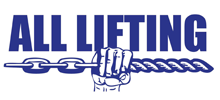
LEVER HOISTS, CHAIN BLOCKS OR COME ALONGS?
Do you have a job to do but you’re not sure which equipment to use? In this article we compare the differences between lever hoists, chain blocks and come alongs.

What is a lever hoist?
Lever hoists are portable devices used to manually lift, lower or pull a load. A lever hoist can also be used for tensioning and lashing loads for transport. Lever hoists have the advantage of being able to lift in most positions, including horizontally and vertically, where chain hoists can typically only be used vertically.
How does a lever hoist work?
Lever hoist’s (also known as blocks) have a handle on the side of the block which houses an internal gearing and ratchet system fitted with load chain. A lever block works by cranking the lever up and down to engage the ratchet and pawl system, which causes the load to move a set distance per crank. The direction of the internal gear can be easily switched, to move the load up or down as needed. There is a hook on the end of the load chain for easy attachment to a load, and a hook attached to the housing of the lever block for attachment to secure support (e.g. steel beam).
The load chain on a lever hoist comes in standard lengths of 1.5 or 3 meters, with working load limits available from 250kg – 9 tonne. Other sizes available at request.

What is a chain block?
Chain blocks are portable devices used to manually lift or lower a load. A hand-operated chain hoist is usually smaller and more compact compared to an electric hoist of the same size. Chain blocks are able to lift in a vertical position only. If they are side loaded or used horizontally it is possible for the mechanism to jam.
How does a chain block work?
A chain block is operated manually, made from a combination of internal geared pulleys fitted with chain. The user will pull down on the hand chain, this will turn a pulley mechanism inside the hoist to move the load. There is a hook on the end of the load chain for ease of attachment to the load and a hook on top to secure the chain hoist to a suitable support.
Chain blocks are available in either a manual or electric mechanism, with sizes available from 250kg – 20t in 3 and 6metre heights of lift. Other sizes are available at request.


What is a come along?
A come along (also called a wire rope hand ratchet puller) is a manual device that can make moving heavy loads by hand possible.
How does it work?
A wire rope puller operates very similarly to a lever block except with wire rope instead of chain. To release the cable from the reel, make sure the mechanism is in a neutral position. Used for pulling only, they cannot be used for any lifting applications.
Come along’s are available in 1, 1.5 and 2t working loads.
For lifting purposes
Every certified lever and chain block will be manufactured to be capable of lifting a specific working load limit e.g. 2 ton. The total weight of the load to be lifted (including the weight of any rigging equipment attached) must not exceed this working load limit. The WLL of a lifting device will be clearly displayed on the side of the hoist, along with the manufacturer and serial number.
For lashing purposes
Cable pullers and lever hoists can be used for lashing. These are commonly used in the transport industry for tensioning or pulling a heavy load.
For more information call our lifting & riggings specialist's today or check out our online store.
Watch our video on lever hoist operations:

